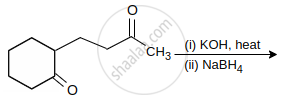Advertisements
Advertisements
Question
Write structural formulas and names of four possible aldol condensation products from propanal and butanal. In each case, indicate which aldehyde acts as nucleophile and which as electrophile.
Solution
The possible products of aldol condensation from propanal and butanal are:
(i) \[\begin{array}{cc}
\phantom{..............................}\ce{OH}\phantom{...}\ce{CH3}\\
\phantom{...........................}|\phantom{.....}|\\
\ce{\underset{Propanal}{2CH3CH2CHO}->[dil.\overset{-}{O}H]\underset{3-Hydroxy-2-methylpentanal}{H3C - CH2 - CH - CH - CHO}}\\
\end{array}\]
(ii) \[\begin{array}{cc}
\phantom{.......................................}\ce{OH}\phantom{..}\ce{CH2CH3}\\
\phantom{................................}|\phantom{.....}|\\
\ce{\underset{Butanal}{2CH3(CH2)2CHO}->[dil.\overset{-}{O}H]\underset{2-Ethyl-3-hydroxyhexanal}{H3C - (CH2)2 - CH - CH - CHO}}\
\end{array}\]
(iii) When butanal acts as an electrophile and propanal as a nucleophile:
\[\begin{array}{cc}
\phantom{...........................................}\ce{OH}\\
\phantom{.........................................}|\\
\ce{\underset{Butanal}{H3C - (CH2)2CHO} + \underset{Propanal}{CH3CH2CHO}->[\overset{-}{O}H]H3C - (CH2)2 - CH - CH - CHO}\\
\phantom{.....................................................}|\\
\phantom{.........................................................}\ce{\underset{3-Hydroxy-2-methylhexanal}{CH3}}\
\end{array}\]
(iv) When propanal serves as an electrophile and butanal as a nucleophile:
\[\begin{array}{cc}
\phantom{............................................}\ce{OH}\phantom{...}\ce{C2H5}\\
\phantom{.........................................}|\phantom{......}|\\
\ce{CH3CH2CHO + CH3(CH2)2CHO -> \underset{2-Ethyl-3-hydroxypentanal}{H3C - CH2 - CH - CH - CHO}}\
\end{array}\]
APPEARS IN
RELATED QUESTIONS
A compound 'A' of molecular formula C2H3OCl undergoes a series of reactions as shown below. Write the structures of A, B, C and D in the following reactions :

What is meant by the following term? Give an example of the reaction in the following case.
Aldol
How will you convert ethanal into the following compound?
Butane-1, 3-diol
How will you bring about the following conversion in not more than two steps?
Ethanol to 3-Hydroxybutanal
How will you bring about the following conversion in not more than two steps?
Benzaldehyde to 3-Phenylpropan-1-ol
Give reasons Acetylation of aniline reduces its activation effect.
Write chemical equations of the following reaction :
Benzoyl chloride is hydrogenated in the presence of `"Pd"/(BaSO_4)`
What is substituted imine called?
Cannizaro’s reaction is not given by ______.
Compounds A and C in the following reaction are:
\[\ce{CH3CHO ->[(i) CH3MgBr][(ii) H2O] (A) ->[H2SO4, Δ] (B) ->[Hydroboration oxidation] (C)}\]
Which of the following conversions can be carried out by Clemmensen Reduction?
(i) Benzaldehyde into benzyl alcohol
(ii) Cyclohexanone into cyclohexane
(iii) Benzoyl chloride into benzaldehyde
(iv) Benzophenone into diphenyl methane
What product will be formed on reaction of propanal with 2-methylpropanal in the presence of \[\ce{NaOH}\]? What products will be formed? Write the name of the reaction also.
Why are carboxylic acids more acidic than alcohols or phenols although all of them have hydrogen atom attached to a oxygen atom \[\ce{(-O-H)}\]?
Give reasons to support the answer:
Presence of Alpha hydrogen in aldehydes and ketones is essential for aldol condensation.
Cross aldol condensation occurs between
Which of the following gives aldol con~ensation reaction?
The major product of the following reaction is:


Identify A and B:
When acetaldehyde is treated with dilute NaOH, the following reaction is observed.
\[\begin{array}{cc}
\ce{2CH3 - CHO ->[dil.NaOH] CH3 - CH - CH2 - CHO}\\
\phantom{...............}|\\
\phantom{.................}\ce{OH}
\end{array}\]
- What are the functional groups in the product?
- Can another product be formed during the same reaction? (Deduce the answer by doing atomic audit of reactant and product).
- Is this an addition reaction or condensation reaction?
